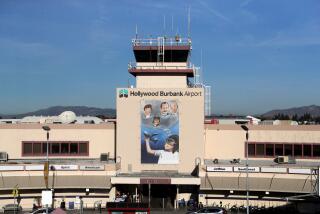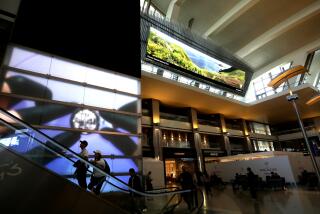Report Cites Runway Risks at Small Airports
Although many of the nationâs bigger airports, including LAX, have received attention over an increase in near collisions on runways, busy smaller airports are not getting the help they need from the FAA to solve the growing problem, federal officials said Tuesday.
Several smaller airports ranked by the Federal Aviation Administration as among those with the most near collisions from 1997 to 2000, including Long Beach Airport and Montgomery Field in San Diego, are not scheduled to receive systems that would reduce these incidents, according to a report by the Department of Transportation.
âThe FAA needs to determine whether low-cost technological solutions are available to reduce runway incursions and prevent accidentsâ at these airports, the report concluded.
The study was conducted by the departmentâs inspector general as part of a series of investigations into the FAAâs progress in addressing near collisions on the nationâs runways--considered the most serious issue confronting aviators today.
The FAA âdid not give a high priority to completing its evaluationâ of a system installed at Long Beach Airport that uses magnetic fields emitted by cables installed on the airfield to determine where airplanes are and how fast they are moving, the report said.
But the FAA is moving ahead and will revise this system to include technology that will turn stoplights on at intersections of taxiways and runways when pilots pass over the cables, said Chris Kunze, the airport manager at Long Beach. The agency will start testing the revised system this year, he added.
âThis is promising, because the technology is pretty basic, and it allows direct feedback to pilots without going through the air traffic controllers,â Kunze said.
Long Beach, ranked among the 32 busiest U.S. airports, had the nationâs fifth-highest number of near collisions from 1997 to 2000, according to an FAA report released last week. A number of different-sized aircraft--including jets, helicopters and small planes--use the airportâs five crisscrossing runways daily, adding to the complexity of the issue, Kunze said.
He said the airport is working to reduce near collisions by increasing the size of âhold bars,â which show pilots where to stop on taxiways, and by distributing videos and posters to pilots showing hot spots on the airfield.
The inspector generalâs report, its third on runway incursions since 1998, accused the FAA of not moving fast enough to install new technology that would help reduce these incidents at airports with the highest number of near collisions.
âDespite significant management focus, it is apparent that [the] FAAâs efforts, along with those of the aviation industry and airports, are not sufficient,â said Kenneth M. Mead, the Transportation Departmentâs inspector general, in testimony Tuesday before the House Subcommittee on Aviation, and its Committee on Transportation and Infrastructure. âThe number of runway incursions continues to go in the wrong direction.â
More to Read
Inside the business of entertainment
The Wide Shot brings you news, analysis and insights on everything from streaming wars to production â and what it all means for the future.
You may occasionally receive promotional content from the Los Angeles Times.








